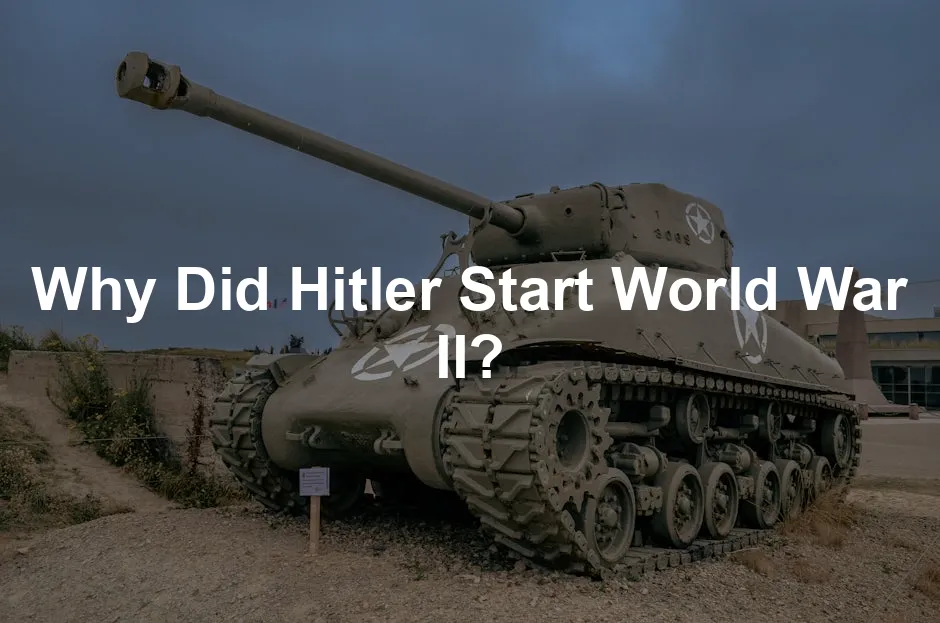
Why Did Hitler Start World War II?
Introduction
Adolf Hitler, the infamous leader of Nazi Germany, played a crucial role in the onset of World War II. Understanding the reasons behind the war’s outbreak provides valuable insights into history. This section will examine the complex causes that led Hitler to initiate this global conflict.
Summary and Overview
The events leading to World War II were rooted in a series of political and social tensions. The Treaty of Versailles, signed in 1919, imposed severe restrictions on Germany after World War I. These harsh terms created a climate of resentment among Germans. Economic struggles, such as hyperinflation and the Great Depression, intensified this discontent.
Hitler and the Nazi Party capitalized on this turmoil. Their ideology emphasized nationalism, militarism, and a desire to reclaim lost territories. Key events like the remilitarization of the Rhineland and the annexation of Austria signaled Hitler’s ambitions. The invasion of Poland on September 1, 1939, marked the war’s official beginning. This act prompted Britain and France to declare war on Germany, thrusting the world into chaos.

If you’re curious about the detailed events leading to this chaos, “The Rise and Fall of the Third Reich” by William L. Shirer offers an extensive look at the era and its implications.
The Treaty of Versailles
The Treaty of Versailles imposed severe penalties on Germany after World War I. Germany lost significant territories, faced military limitations, and had to pay hefty reparations. These conditions devastated the German economy and fostered deep resentment. Many Germans felt humiliated, believing the treaty was unjust. The consequences of this treaty laid the groundwork for the rise of extremist ideologies, including Hitler’s.
The treaty’s impact was profound. Economic struggles led to widespread unemployment, creating fertile ground for radical political movements. Nationalist sentiments surged as Hitler promised to restore Germany’s former glory. This sense of nationalism played a pivotal role in Hitler’s appeal, allowing him to rally the populace around a common cause.

To dive deeper into the historical context, consider reading “The Treaty of Versailles: A History” by Michael S. Neiberg.
The Weimar Republic and Economic Instability
The Weimar Republic faced significant political instability from its inception. Established in 1919, it struggled with numerous parties and frequent changes in leadership. This lack of unity contributed to widespread dissatisfaction among the German populace.
Hyperinflation hit Germany hard in the early 1920s. The currency rapidly lost value, leading to dire financial conditions for many families. People could hardly afford basic necessities, and savings were wiped out. This economic chaos led to anger and frustration towards the government.

The Great Depression of 1929 further exacerbated these issues. Unemployment skyrocketed, and many Germans lost faith in democracy. Economic despair made extremist parties, like the Nazis, more appealing. They promised stability, jobs, and a return to national pride.
For those intrigued by the personal stories of this turbulent time, “The Nazi Officer’s Wife: How One Jewish Woman Survived the Holocaust” by Edith Hahn Beer is a gripping read.
As a result, the Nazis gained traction in the political landscape. They exploited public grievances and fears, presenting themselves as the solution. This environment paved the way for Hitler’s rise to power, ultimately leading to the outbreak of World War II.
Nazi Ideology and Expansionism
Nazi ideology revolved around several key tenets. Central to this was the belief in Aryan supremacy. The Nazis viewed Aryans as the “master race,” destined to rule over others. This belief justified their aggressive policies and expansionist ambitions.
Anti-Semitism was another fundamental aspect of Nazi ideology. Hitler’s regime scapegoated Jews for Germany’s problems, falsely portraying them as a threat. This hatred provided a rallying point for the Nazi movement, uniting supporters against a common enemy.

The concept of Lebensraum, or “living space,” drove Hitler’s expansionist policies. He argued that Germany needed more territory for its growing population. This idea justified aggressive actions against neighboring countries, including Poland and Czechoslovakia. Hitler believed that conquering these lands was essential for Germany’s survival and prosperity.
For a deeper understanding of the ideological underpinnings, check out “Hitler: Ascent 1889-1939” by Volker Ullrich.
Historical Grievances and Nationalism
Historical grievances played a crucial role in fueling nationalist sentiment in Germany. The Treaty of Versailles, signed in 1919, imposed harsh penalties on Germany after World War I. These terms resulted in territorial losses and significant reparations, creating a sense of humiliation among Germans.
Hitler effectively capitalized on these feelings. He painted a picture of a strong, united Germany that could reclaim its lost glory. By tapping into the emotions of resentment and pride, he gained widespread support. Many Germans embraced his vision of a powerful nation, overlooking the dangers of his regime’s ideology.

In summary, the combination of economic instability, ideological beliefs, and historical grievances set the stage for Hitler’s aggressive policies and the eventual outbreak of World War II. Understanding these factors is crucial in comprehending the war’s origins and the destructive path that followed.
Hitler’s Rise to Power
Adolf Hitler’s ascent began in the turbulent years after World War I. Germany was reeling from the Treaty of Versailles, which imposed harsh penalties. This created fertile ground for extremist parties like Hitler’s National Socialist German Workers’ Party (Nazi Party).
In 1933, Hitler was appointed Chancellor. The Reichstag Fire in February allowed him to claim a state of emergency, leading to the Reichstag Fire Decree. This decree suspended civil liberties, enabling the Nazis to arrest political opponents.

The passage of the Enabling Act in March 1933 solidified Hitler’s power. This law allowed his cabinet to enact laws without parliamentary approval. By July 1933, the Nazi Party was the only legal political entity in Germany.
During these years, Hitler skillfully eliminated rivals and consolidated control. His regime used propaganda and violence, creating a totalitarian state. By the late 1930s, he had established a firm grip on Germany, setting the stage for aggressive foreign policies.
For those interested in military strategies and historical accounts, “The Second World War” by Sir Winston S. Churchill provides a comprehensive overview.
Early Aggressions and Expansion
Hitler’s aggressive policies began soon after he consolidated power. One of his first major moves was the remilitarization of the Rhineland in 1936. This act violated the Treaty of Versailles but faced little opposition from Britain or France, emboldening him further.
In March 1938, Hitler executed the Anschluss, annexing Austria without firing a shot. This bold move went unchecked, increasing his confidence. The following September, tensions rose over the Sudetenland in Czechoslovakia. The Munich Agreement allowed Hitler to annex this region with promises of peace from Britain and France.
If you’re keen on strategy games that reflect this historical tension, consider a WWII Strategy Game to challenge your tactical skills!
These early acts of aggression showcased Hitler’s ambition. Each success increased his belief in his invincibility. The lack of firm responses from Western powers only encouraged his expansionist policies, leading directly to the eventual invasion of Poland in 1939.
Policy of Appeasement
The policies of appeasement adopted by Britain and France aimed to maintain peace. Leaders like British Prime Minister Neville Chamberlain believed that satisfying Hitler’s demands would prevent war. The Munich Agreement is a prime example of this approach.

By allowing Germany to annex the Sudetenland, Western powers failed to confront Hitler’s ambitions. This decision ultimately backfired, as it only fueled his aggression. The belief that Hitler could be contained through negotiation proved misguided.
As tensions escalated, the inadequacy of appeasement became clear. Hitler continued his expansion, disregarding international agreements. The failure of Britain and France to respond decisively set the stage for the outbreak of World War II. Their reluctance to confront aggression allowed Hitler to act with impunity, culminating in the invasion of Poland.
The Role of the League of Nations
The League of Nations was established after World War I. Its primary goal was to maintain peace and prevent future conflicts. However, it faced significant weaknesses. These flaws prevented it from effectively addressing aggression by Axis powers like Germany and Italy.
One major issue was the League’s lack of enforcement power. It relied on member nations to implement sanctions or military action. Unfortunately, many countries were unwilling to take strong measures. For instance, during Italy’s invasion of Ethiopia in 1935, the League imposed limited sanctions but failed to take decisive action. This inaction emboldened aggressor nations and showcased the League’s impotence.

Another notable failure occurred in 1931 when Japan invaded Manchuria. The League condemned the invasion but did little else. Japan simply withdrew from the League in response. These events highlighted the League’s inability to deter aggressive actions, ultimately undermining its credibility.
The Danzig Crisis
Danzig, now known as Gdańsk, held significant importance before World War II. This free city, primarily inhabited by Germans, was established after the Treaty of Versailles. It sat on the Polish Corridor, a crucial trade route for Poland. Germany’s insistence on reclaiming Danzig created severe diplomatic tensions.
In the months leading up to the war, Hitler issued ultimatums to Poland regarding Danzig. He demanded access to the city and control over the Polish Corridor. Poland, backed by Britain and France, refused these demands. The situation escalated as diplomatic negotiations failed, increasing the likelihood of conflict.
The Molotov-Ribbentrop Pact
On August 23, 1939, Nazi Germany and the Soviet Union signed the Molotov-Ribbentrop Pact. This non-aggression treaty shocked the world. It allowed Hitler to invade Poland without fearing a Soviet counterattack. The secret protocol of the pact divided Eastern Europe into spheres of influence.

The implications of this agreement were profound. With Soviet support secured, Germany launched its invasion of Poland just days later, on September 1, 1939. This act marked the official beginning of World War II. The pact not only facilitated the invasion but also set the stage for future conflicts in Europe, showcasing the dangerous alliances that would shape the war’s trajectory.
The Actual Invasion
On September 1, 1939, Nazi Germany launched its invasion of Poland. This marked a pivotal moment in history. The attack was swift and brutal, employing a military strategy known as Blitzkrieg, or “lightning war.” It combined fast-moving armored units with air support to overwhelm Polish defenses quickly.

The invasion began early in the morning. German forces crossed the border and bombed key cities, including Warsaw and Kraków. The Polish army was ill-equipped to handle such a rapid assault. Within weeks, Poland was in ruins, and its government was forced into exile.
Britain and France had promised to support Poland. As the invasion unfolded, they quickly condemned Germany’s actions. On September 3, 1939, both nations declared war on Germany. This decision marked the official start of World War II. The world held its breath, bracing for the chaos that would follow.
Conclusion
Hitler’s decision to start World War II stemmed from multiple factors. These included his aggressive expansionist policies, historical grievances, and the political instability of Europe. The invasion of Poland was the culmination of years of tension and failed diplomacy.

Understanding these events is crucial. It helps us recognize the dangers of unchecked aggression and the importance of international cooperation. By studying such historical moments, we can strive to prevent similar conflicts in the future.
FAQs
What were the main causes of World War II?
The war was driven by economic turmoil, political instability, and rising nationalism. The Treaty of Versailles created resentment in Germany, contributing to Hitler’s rise.
How did Hitler’s ideology contribute to the war?
Hitler’s beliefs justified territorial expansion and aggression. He promoted Aryan supremacy and targeted minorities, fueling conflict throughout Europe.
What role did the Treaty of Versailles play in the rise of Hitler?
The treaty’s harsh terms fostered resentment. Many Germans felt humiliated, creating fertile ground for extremist ideologies like Nazism to take root.
What was the significance of the Munich Agreement?
The Munich Agreement allowed Hitler to annex the Sudetenland, reflecting the failure of appeasement strategies that only encouraged further aggression.
Did the Soviet Union play a role in the outbreak of World War II?
Yes, the Molotov-Ribbentrop Pact allowed Germany to invade Poland without fear of Soviet intervention, leading to the division of Eastern Europe.
Why was the invasion of Poland considered the start of World War II?
The invasion triggered immediate declarations of war from Britain and France, marking a significant escalation in global conflict.
How did Hitler consolidate power before the war?
Key legislative actions, like the Reichstag Fire and the Enabling Act, allowed him to suppress opposition and establish a totalitarian regime.
Please let us know what you think about our content by leaving a comment down belove!
Thank you for reading till here 🙂
All images from Pexels




